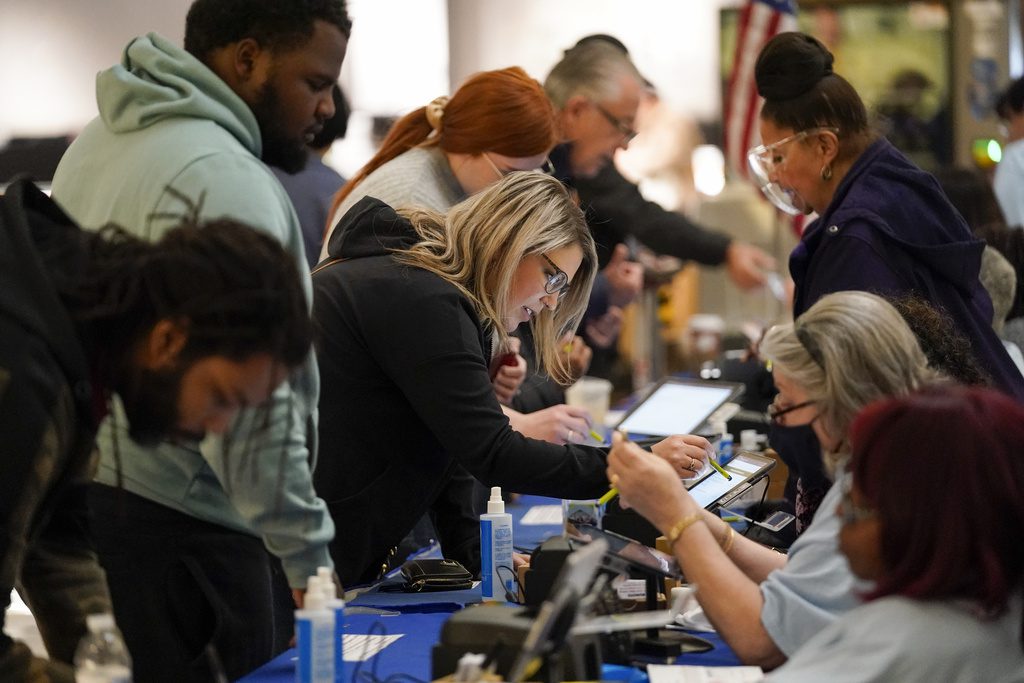
FILE--In this Nov. 6, 2018, file photo, people vote in Henderson, Nev. (AP Photo/John Locher, file)
In 2022, nearly half a million voters in Nevada cast their ballot before Election Day during the early voting period. And that was during a midterm — and that number doesn’t even include mail ballots!
Considering the significance of this year’s election — not to mention predictions that turnout will be high — we’ve put together a quick guide on everything you need to know about early voting in Nevada.
So when does early voting begin for the 2024 election?
Early voting in Nevada takes place two weeks before Election Day, which is Nov. 5. Meaning polls will open for early voting on Oct. 19 and run through Nov. 1.
Where can I vote early?
Nevadans can vote early in person or by mail. The secretary of state’s website has a list of polling locations and their hours of operation in each county — many are schools, community centers, or government buildings, you might even find a tent voting site set up in popular shopping centers.
Polling locations also have ballot drop-off boxes where voters can return their completed mail ballots (just don’t forget to sign it!). Mail ballots can also be sent back as normal mail anytime before Nov. 5 — they must be postmarked by 5 p.m. on Election Day. More on mail ballots here.
For voters in Clark County, the election department established an early voting site locator where voters can look for their nearest polling place. In Washoe County, the elections department has an interactive map of all of the voting locations.
What else should I know about early voting?
Since 2022, every registered voter in Nevada is sent a mail-in ballot, so make sure you’re registered to vote and your information is up to date.
If you choose to go in person, early voting is very much just like voting on Election Day. Upon arriving at the voting site, your eligibility and signature will be verified before you are allowed to cast a ballot. Computers at each site are connected to the county’s election department and their registration files to prevent the possibility of anyone voting twice.
In the days before early voting even starts, all active voters receive a sample ballot in the mail (or by email). While sample ballots are not used to cast your vote, they have names of the candidates and details on polling locations.
Election officials encourage voters to use the sample ballots as a study guide, and use it to look up more information about the candidates and take notes or mark it so when it comes time to fill out the ballot it can be used as a reference and be better prepared.
If you go to a polling place in person, you might find tents with campaign signs where volunteers with the candidate, or the candidate themselves, may try to talk to you about their positions. (Thing to know: they must be at least 100 feet away from the entrance.) While they aim to be informative, they are not allowed to coerce you to vote for them.
You might also encounter public observers. Public observers are regular people (not poll workers — poll workers are often in shirts that have a county logo) who often sit and watch the process. They typically stand in a dedicated area where they can watch people cast their ballots, but far enough to not infringe on your privacy and the confidentiality of your ballot. Observers cannot view your personal information, ballot, or your selections on a voting machine; they cannot disrupt voting or election workers, nor are they allowed to talk with voters.
Campaigning inside the voting site, such as wearing or bringing any campaign item into the voting area, is not allowed.
Voters in Nevada have the right to vote free from intimidation under federal and state law. And while Nevada does not have an explicit law banning guns or open-carry in polling places, firearm carry is generally illegal in several locations that are often used as polling locations, such as schools and government buildings. Even at locations where firearms are not prohibited, open-carry might constitute unlawful intimidation.
Are you ready to vote? Make sure to check your voter registration status, see who’s on your ballot, and make a voting plan here.

A pesar de las mentiras sobre el fraude electoral, la votación anticipada se ha desarrollado en gran medida sin problemas hasta ahora en Nevada
En medio de continuas mentiras y conspiraciones sobre fraude electoral por parte de círculos de extrema derecha, los nevadenses están expresando...

Despite lies about voter fraud, early voting has been largely smooth so far in Nevada
Amid ongoing lies and conspiracies about voter fraud from far-right circles, Nevadans are expressing confidence in the state’s election system and...

Opinion: Question 7 would create barriers for seniors and potentially lead to voters being turned away
Question 7 is an unnecessary barrier to voting. Simply put, there is no widespread voter fraud in Nevada; it is not something that has ever...

NV Supreme Court upholds ruling on mail ballots received post-Election Day
The Nevada Supreme Court noted in its opinion, which was posted by Democracy Docket, that the RNC identified 24 non-postmarked mail ballots that...

What to Know About Question 7 on Nevada’s Ballot






